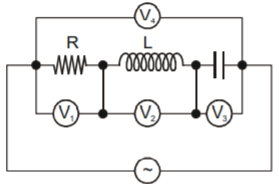In an L-C-R series AC circuit, the voltage across each of the components - L, C and R is 50 V. The voltage across the L-R combination will be:
1. 50 V
2. \(50 \sqrt{2} ~V\)
3. 100 V
4. 0 V
1. 50 V
2. \(50 \sqrt{2} ~V\)
3. 100 V
4. 0 V
An AC voltage source is connected to a series \(LCR\) circuit. When \(L\) is removed from the circuit, the phase difference between current and voltage is \(\frac{\pi}{3}\). If \(C\) is instead removed from the circuit, the phase difference is again \(\frac{\pi}{3}\) between current and voltage. The power factor of the circuit is:
1. \(0.5\)
2. \(1.0\)
3. \(-1.0\)
4. zero
A transistor-oscillator using a resonant circuit with an inductance L (of negligible resistance) and a capacitance C has a frequency f. If L is doubled and C is changed to 4C, the frequency will be:
1. f/4
2. 8f
3. f/(2√2)
4. f/2
An ideal resistance R, ideal inductance L, ideal capacitance C, and AC voltmeters are connected to an AC source as shown. At resonance:

| 1. | Reading in \(V_3\) = Reading in \(V_1\) |
| 2. | Reading in \(V_1\) = Reading in \(V_2\) |
| 3. | Reading in \(V_2\) = Reading in \(V_4\) |
| 4. | Reading in \(V_2\) = Reading in \(V_3\) |
An L-C-R series circuit with 100 Ω resistance is connected to an AC source of 200 V and an angular frequency of 300 rad/s. When only the capacitance is removed, the current lags behind the voltage by . When only the inductance is removed, the current leads the voltage by . Calculate the power dissipated in the L-C-R circuit.
1. 200 W
2. 400 W
3. 300 W
4. Zero
A direct current of \(5~ A\) is superimposed on an alternating current \(I=10sin ~\omega t\) flowing through a wire. The effective value of the resulting current will be:
| 1. | \(15/2~A\) | 2. | \(5 \sqrt{3}~A\) |
| 3. | \(5 \sqrt{5}~A\) | 4. | \(15~A\) |
In a transformer, the number of turns in the primary and secondary coils is 410 and 1230 respectively. If the current in the primary is 6 A, then what is the current in the secondary coil?
| 1. | 2 A | 2. | 18 A |
| 3. | 12 A | 4. | 1 A |
If q is the capacitor's charge and i is the current at time t, the voltage V will be:

| 1. | \(\mathrm{L} \frac{\mathrm{di}}{\mathrm{dt}}+\mathrm{iR}-\frac{\mathrm{q}}{\mathrm{C}}=\mathrm{V}\) |
| 2. | \(\mathrm{L} \frac{\mathrm{di}}{\mathrm{dt}}-\mathrm{iR}+\frac{\mathrm{q}}{\mathrm{C}}=\mathrm{V}\) |
| 3. | \(\mathrm{L} \frac{\mathrm{di}}{\mathrm{dt}}+\mathrm{iR}+\frac{\mathrm{q}}{\mathrm{C}}=\mathrm{V}\) |
| 4. | \(\mathrm{L} \frac{\mathrm{di}}{\mathrm{dt}}-\mathrm{iR}-\frac{\mathrm{q}}{\mathrm{C}}=\mathrm{V}\) |
An AC ammeter is used to measure the current in a circuit. When a given direct current passes through the circuit, the ac ammeter reads 6 A. When another alternating current passes through the circuit, the AC ammeter reads 8 A. Then the reading of this ammeter if DC and AC flow through the circuit simultaneously is:
1. A
2. 14 A
3. 10 A
4. 15 A
The AC source in the circuit shown in the figure produces a voltage \(V = 20\cos(2000t)\) volts. Neglecting source resistance, the voltmeter and ammeter readings will be (approximately):
1. \(4~\text{V}, 2.0~\text{A}\)
2. \(0~\text{V}, 2~\text{A}\)
3. \(5.6~\text{V}, 1.4~\text{A}\)
4. \(8~\text{V}, 2.0~\text{A}\)

